About Shimmer
“Shimmer” is composed entirely of hand painted butterflies and moths. Once the paintings were complete, I created a digital collage that, from a short distance, creates the beautiful illusion of a large stained glass window or mandala.
The Butterflies & Moths
I have posted a few of my individual paintings of the butterflies and moths that make up Shimmer. These amazing living creatures are truely artworks in themselves. I already have plans to feature more of them in future works.
Appalachian Tiger Swallow (Papilio appalachiensis) Butterfly
 Papilio appalachiensis, the Appalachian Tiger Swallowtail, is a species of swallowtail butterfly found in the eastern United States, particularly in the Appalachian Mountains. It is a hybrid of another two Papilio species, Papilio canadensis and Papilio glaucus, with whom it shares many characteristics. The butterflies are normally yellow and contain black patters in their wings. Their winspan ranges from 86 to 115 mm. The caterpillars range in color from green and yellow to orange and are ornamented with black specks that give them the appearance of a bird dropping, which is useful for camouflage, or a large eye, a form of mimicry that is also efficient for protection. This species is univoltine. Females lay their eggs in May and caterpillars undergo chrysalis throughout the winter. Pupation occurs in June or July.
Papilio appalachiensis, the Appalachian Tiger Swallowtail, is a species of swallowtail butterfly found in the eastern United States, particularly in the Appalachian Mountains. It is a hybrid of another two Papilio species, Papilio canadensis and Papilio glaucus, with whom it shares many characteristics. The butterflies are normally yellow and contain black patters in their wings. Their winspan ranges from 86 to 115 mm. The caterpillars range in color from green and yellow to orange and are ornamented with black specks that give them the appearance of a bird dropping, which is useful for camouflage, or a large eye, a form of mimicry that is also efficient for protection. This species is univoltine. Females lay their eggs in May and caterpillars undergo chrysalis throughout the winter. Pupation occurs in June or July.
Atlas (Attacus atlas) Moth
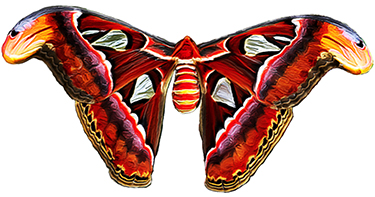 The Atlas moth (Attacus atlas) is a large saturniid moth found in the tropical and subtropical forests of Southeast Asia, and is common across the Malay archipelago. Atlas moths are considered the largest moths in the world in terms of total wing surface area, reaching upwards of 62 sq in. Their wingspans are also amongst the largest, reaching over 10 in. Females are appreciably larger and heavier than the males.
Atlas moths are said to be named after either the Titan of Greek mythology, or their map-like wing patterns. In Hong Kong the Cantonese name translates as "snake's head moth", referring to the apical extension of the forewing, which bears a more than passing resemblance to a snake's head.
The Atlas moth (Attacus atlas) is a large saturniid moth found in the tropical and subtropical forests of Southeast Asia, and is common across the Malay archipelago. Atlas moths are considered the largest moths in the world in terms of total wing surface area, reaching upwards of 62 sq in. Their wingspans are also amongst the largest, reaching over 10 in. Females are appreciably larger and heavier than the males.
Atlas moths are said to be named after either the Titan of Greek mythology, or their map-like wing patterns. In Hong Kong the Cantonese name translates as "snake's head moth", referring to the apical extension of the forewing, which bears a more than passing resemblance to a snake's head.
Bamboo Page (Philaethria dido) Butterfly
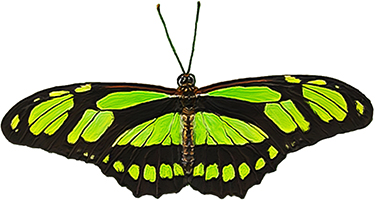 The scarce Bamboo Page or Dido Longwing (Philaethria dido) is a butterfly in the family Nymphalidae. It is found in Central America and tropical South America, both east and west of the Andes, from Brazil and Ecuador northwards to Mexico. Strays can sometimes be found in the lower Rio Grande Valley in southern Texas.
The scarce Bamboo Page or Dido Longwing (Philaethria dido) is a butterfly in the family Nymphalidae. It is found in Central America and tropical South America, both east and west of the Andes, from Brazil and Ecuador northwards to Mexico. Strays can sometimes be found in the lower Rio Grande Valley in southern Texas.
Menelaus Blue Morpho (Morpho menelaus) Butterfly
 An iridescent tropical butterfly of Central and South America. It has a wing span of 5.9 inches. The adult drinks juice from rotten fruit with its long proboscis, which is like a sucking tube. The adult males have brighter colors than the females. The forewing is concave at the outer edge. The upperside of wings are metallic blue.The underside is brown with a line of large ocelli at the base of the postdiscal area.
An iridescent tropical butterfly of Central and South America. It has a wing span of 5.9 inches. The adult drinks juice from rotten fruit with its long proboscis, which is like a sucking tube. The adult males have brighter colors than the females. The forewing is concave at the outer edge. The upperside of wings are metallic blue.The underside is brown with a line of large ocelli at the base of the postdiscal area.
Clouded Sulphur (Colias philodice) Butterfly
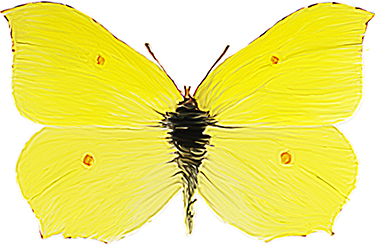 The Clouded Sulphur (Colias philodice) is a North American butterfly in the family Pieridae, subfamily Coliadinae. The upper side of the male's wings is yellow with black borders. The upper side of the female's wings is either yellow or greenish-white with yellow- or white-spotted black borders. The underside of the male's wings is yellow while the female's is yellow or greenish-white, and both have a double hind wing spot trimmed in brownish-red. Its wingspan 32 to 54 mm. This butterfly may be encountered in fields, lawns, Alfalfa or Clover fields, meadows, and roadsides. Swarms of these butterflies will congregate at mud puddles. They range over most of North America with the exception of Labrador, Nunavut, and northern Quebec.
The Clouded Sulphur (Colias philodice) is a North American butterfly in the family Pieridae, subfamily Coliadinae. The upper side of the male's wings is yellow with black borders. The upper side of the female's wings is either yellow or greenish-white with yellow- or white-spotted black borders. The underside of the male's wings is yellow while the female's is yellow or greenish-white, and both have a double hind wing spot trimmed in brownish-red. Its wingspan 32 to 54 mm. This butterfly may be encountered in fields, lawns, Alfalfa or Clover fields, meadows, and roadsides. Swarms of these butterflies will congregate at mud puddles. They range over most of North America with the exception of Labrador, Nunavut, and northern Quebec.
Clymene (Haploa clymene) Moth
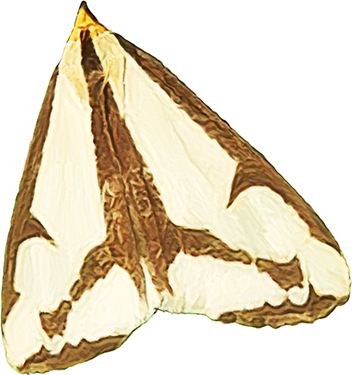 A moth of the Tiger Moth family - Arctiidae, subfamily Arctiinae. It is found in the East of North America. The fore wing is creamy-yellow with a partial brown-black border that extends inward from the inner margin near anal angle. The hind wing is yellow-orange with 1-2 brown-black spots. The wingspan is 40–55 mm.
A moth of the Tiger Moth family - Arctiidae, subfamily Arctiinae. It is found in the East of North America. The fore wing is creamy-yellow with a partial brown-black border that extends inward from the inner margin near anal angle. The hind wing is yellow-orange with 1-2 brown-black spots. The wingspan is 40–55 mm.
Indian Leafwing (Kallima paralekta) Butterfly
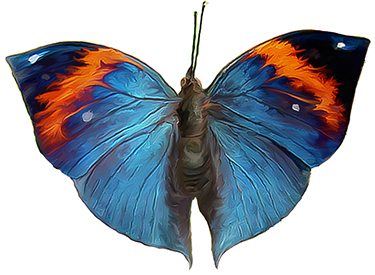 Commonly known as the Indian Leafwing or the Malayan Leafwing, it is a species of brush-footed butterfly of the genus Kallima. Despite its common names, it is not found in India or Malaysia, but is endemic to Java and Sumatra of Indonesia. Like other members of its genus, it is remarkable for its strong resemblance to a dead leaf when its wings are folded. It was one of the species encountered by the British naturalist Alfred Russel Wallace in his travels in maritime Southeast Asia. It is mentioned in his famous 19th-century work The Malay Archipelago as one of the best examples of protective camouflage achieved through natural selection.
Commonly known as the Indian Leafwing or the Malayan Leafwing, it is a species of brush-footed butterfly of the genus Kallima. Despite its common names, it is not found in India or Malaysia, but is endemic to Java and Sumatra of Indonesia. Like other members of its genus, it is remarkable for its strong resemblance to a dead leaf when its wings are folded. It was one of the species encountered by the British naturalist Alfred Russel Wallace in his travels in maritime Southeast Asia. It is mentioned in his famous 19th-century work The Malay Archipelago as one of the best examples of protective camouflage achieved through natural selection.
Knapweed Fritillary (Melitaea phoebe) Butterfly
Monarch (Danaus plexippus) Butterfly
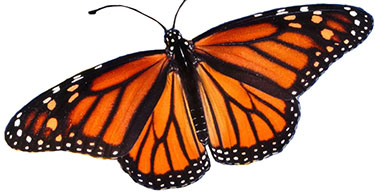 A milkweed butterfly (subfamily Danainae) in the family Nymphalidae. It may be the most familiar North American butterfly. Its wings feature an easily recognizable orange and black pattern, with a wingspan of 3½–4 inches. (The viceroy butterfly is similar in color and pattern, but is markedly smaller, and has an extra black stripe across the hind wing.) The eastern North American monarch population is notable for its multi-generational southward late summer/autumn migration from the United States and southern Canada to Mexico, covering thousands of miles. The western North American population of monarchs west of the Rocky Mountains most often migrate to sites in California but have been found in overwintering Mexico sites.
A milkweed butterfly (subfamily Danainae) in the family Nymphalidae. It may be the most familiar North American butterfly. Its wings feature an easily recognizable orange and black pattern, with a wingspan of 3½–4 inches. (The viceroy butterfly is similar in color and pattern, but is markedly smaller, and has an extra black stripe across the hind wing.) The eastern North American monarch population is notable for its multi-generational southward late summer/autumn migration from the United States and southern Canada to Mexico, covering thousands of miles. The western North American population of monarchs west of the Rocky Mountains most often migrate to sites in California but have been found in overwintering Mexico sites.
Small White Wave (Asthena albulata) Moth
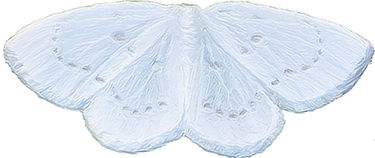 The Small White Wave (Asthena albulata) is a moth of the Geometridae family. It is known from all of Europe and is also present in the Near East. The wingspan is 14–18 mm. The ground color of the wings is white (silky in appearance). There are fine brown cross-lines across both fore and hindwings and a row of black dots along the margin of both wings. There are two generations per year with adults on wing from mid April to Augus
The Small White Wave (Asthena albulata) is a moth of the Geometridae family. It is known from all of Europe and is also present in the Near East. The wingspan is 14–18 mm. The ground color of the wings is white (silky in appearance). There are fine brown cross-lines across both fore and hindwings and a row of black dots along the margin of both wings. There are two generations per year with adults on wing from mid April to Augus
Spotted Fritillary (Melitaea didyma) Butterfly
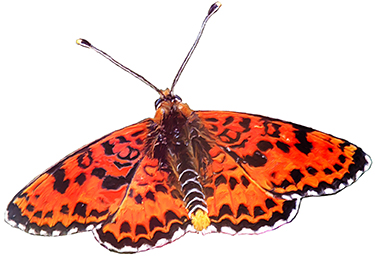 The Spotted Fritillary or Red-band Fritillary (Melitaea didyma) is a butterfly of the Nymphalidae family. Melitaea didyma is a medium size butterfly with a wingspan reaching 1.4–2.0 in. The upperside of the wings is bright orange-brown with dark brown drawings arranged in rows, quite variable in quantity and size. Sometimes the color of the females is duller orange, shaded with gray-green. The undeside of the wings is checkered pale yellow and pale orange. This butterfly flies from March to October depending on the location. It is found primarily in Southern and Central Europe. It is also present in North Africa, in the Middle East (Turkey, Iran to Afghanistan, Kazakhstan, northern Pakistan), in Siberia and in Central Asia (west China and Mongolia). In North Africa this species lives in Morocco, Algeria and Tunisia.
The Spotted Fritillary or Red-band Fritillary (Melitaea didyma) is a butterfly of the Nymphalidae family. Melitaea didyma is a medium size butterfly with a wingspan reaching 1.4–2.0 in. The upperside of the wings is bright orange-brown with dark brown drawings arranged in rows, quite variable in quantity and size. Sometimes the color of the females is duller orange, shaded with gray-green. The undeside of the wings is checkered pale yellow and pale orange. This butterfly flies from March to October depending on the location. It is found primarily in Southern and Central Europe. It is also present in North Africa, in the Middle East (Turkey, Iran to Afghanistan, Kazakhstan, northern Pakistan), in Siberia and in Central Asia (west China and Mongolia). In North Africa this species lives in Morocco, Algeria and Tunisia.
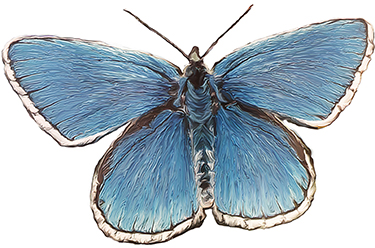
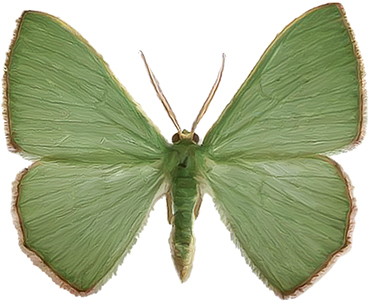
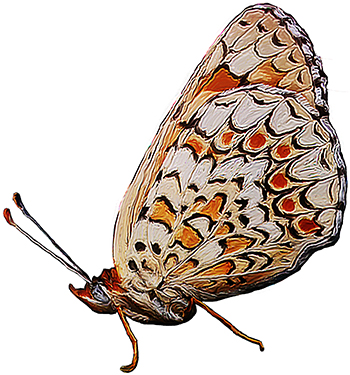
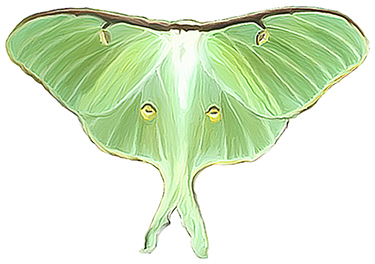
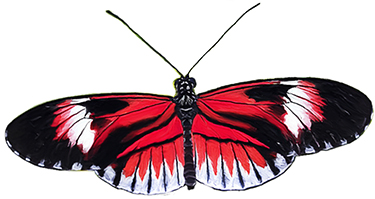
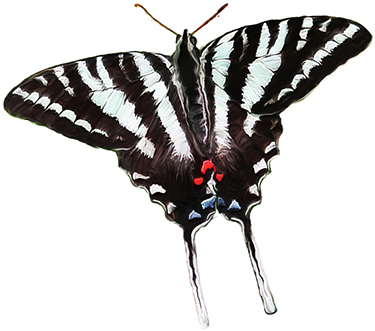
Recent Comments